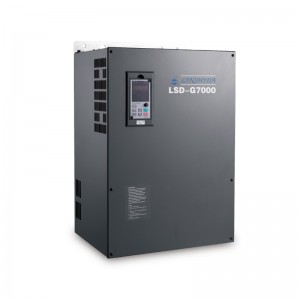The frequency converter is a kind of adjustable speed drive system. It uses variable frequency drive technology to change the frequency and amplitude of the AC motor’s operating voltage to smoothly control the speed and torque of the AC motor. The most common one is AC/ which has AC input and output. AC converter.
The frequency converter has a wide range of applications, from small household appliances to large mine grinders and compressors. About 1/3 of the world’s energy is consumed in motors that drive fixed-speed centrifugal pumps, fans, and compressors, and the market penetration rate of frequency converters is still not high. The significant improvement in energy efficiency is one of the main reasons for the use of frequency converters.
There are two types of inverters: High-performance General Vector Inverter LSD-G7000 and vector inverters. Although both types of inverters can be used, there are still differences between the two types of inverters.
There are two main differences between vector inverters and general inverters. One is high control accuracy, and the other is high output torque at low speed.
Vector dedicated inverter:
The working principle of the vector dedicated inverter is to perform inverter after rectification, and obtain the frequency voltage you want after inverter.
The vector control technology transforms the three-phase system into the MT two-phase system through coordinate transformation, and decomposes the AC motor stator current vector into two DC components (that is, the flux component and the torque component), so as to control the flux linkage and rotation of the AC motor separately. The purpose of torque, so as to achieve the same control effect as the DC speed control system.
Vector control is also called speed control, and some differences can be seen literally.
V/F control mode: When driving, the throttle opening on the foot remains unchanged, and the speed of the car will definitely change! The car walks unevenly and the road resistance is also changing. The speed will slow down when going uphill, and it will go faster when going downhill. For the inverter, the frequency setting value of the inverter is equal to the throttle opening of your feet when driving, and the throttle opening is fixed when the V/F is controlled.
Vector control mode: In the case of changes in road conditions, resistance changes, uphill, downhill, etc., try to keep the vehicle speed constant and improve the speed control accuracy.
General inverter:
The inverter suitable for all loads is a general-purpose inverter. However, if there is a special inverter, it is recommended to use a special inverter. The special inverter is optimized according to the characteristics of the load, and has the characteristics of simple parameter setting, speed regulation, and better energy-saving effects.
Choosing the correct inverter control system is essential for normal operation. When we choose the inverter, we must fully understand the load characteristics of the inverter drive. In practice, the production machinery is divided into three types: constant moment load, constant power load and blower and pump load.
Constant moment load:
Although there is no correlation between the load torque TL and the rotation speed N, TL remains constant or basically uniform at any rotation speed. For example, frictional loads such as conveyor belts, mixers, and extruders, and potential energy loads such as cranes and cranes are all constant moment loads.
When the inverter drives a load with a constant moment, the moment at low speed must be large enough to have sufficient overload capacity. If low-speed stable operation is required, the heat dissipation capacity of the standard asynchronous motor should be considered to avoid excessive temperature rise of the motor.
Constant power load:
The torque required by machine tool spindles, rolling mills, paper machines, and plastic film production lines’ coilers, coilers, etc., is roughly inversely proportional to the speed, which is the so-called constant power load. The constant power nature of the load should be within a certain speed range. At low speeds, due to the limitation of mechanical strength, TL cannot increase indefinitely, so at low speeds it becomes a constant torque property. The size of the load constant power and constant moment zone has a great influence on the selection of the drive scheme. When the motor is in constant flux speed regulation, the maximum allowable output torque does not change. When it belongs to the field weakening speed of constant torque speed regulation, the maximum allowable output torque is inversely proportional to the speed, which belongs to constant power speed regulation. If the constant torque and constant force speed regulation range of the motor is consistent with the constant torque and constant force range of the load, that is, the so-called matching, the capacity of the motor and the capacity of the frequency converter are the smallest.
Post time: Jan-06-2022

